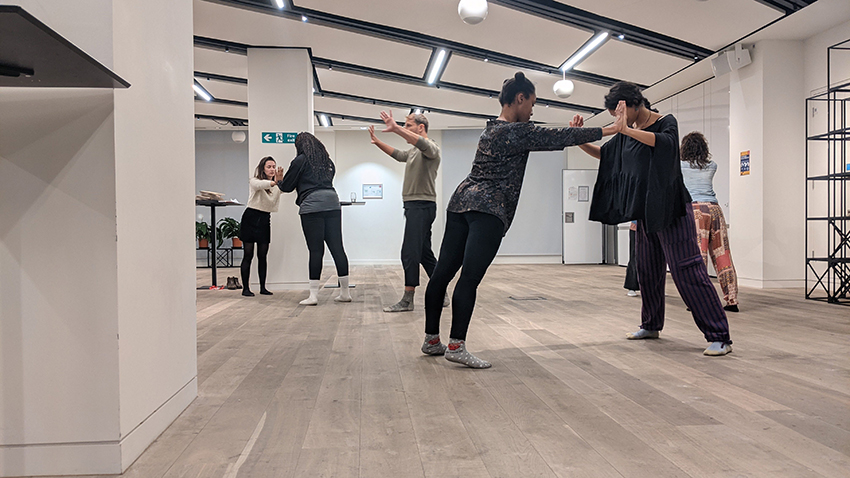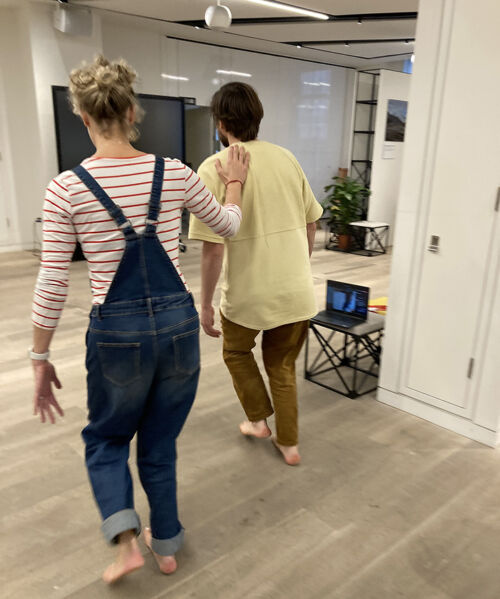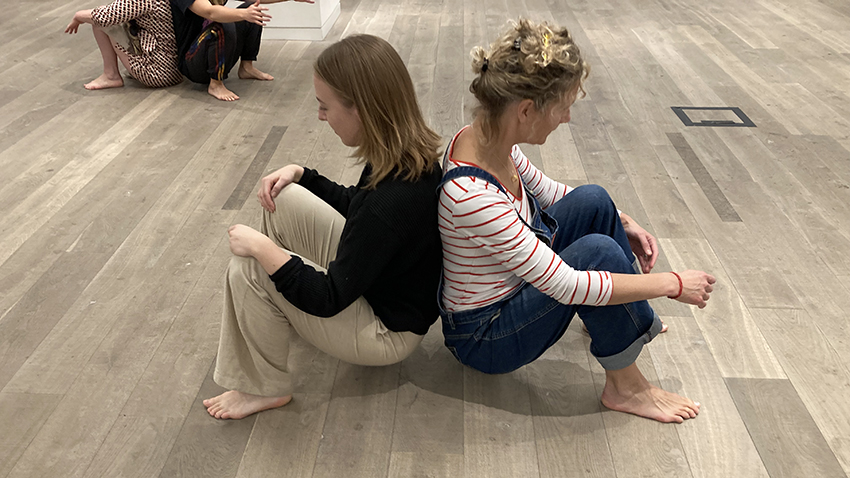Contact Improvisation Exercises

Author: Mark Rietema
Axioms and Assumptions
Before I describe a few possible exercises, it seems good to note some of the underlying assumptions and experiences that I am starting from. As these will form part of my work. These very much come from the lived experience and theory of the different modalities that I work from, namely Body-Mind Centering, Contact Improvisation and Process Oriented Psychology. I feel they are present in all these modalities.
- Body-Mind connection. The fact that Body and Mind are not separate. And that we make sense of information and ‘think’ embodied. Yet, at the same time, recognising that we live in a world that divides body and mind and that can feel threatened or confused by connecting Body and Mind.
- That Embodiment is a process (not a state), that is partially about engaging with my subjective interpersonal experiences, but also includes cultural and societal components. We are formed and influence not only by your own physical experiences but also societies beliefs and attitudes in non-linear way. (this has impact on teaching, not only about increasing sense of body, but also dealing with Societies Edges in the workshops)
- Systems Theory – That a focus on the relationship between parts (anatomically, but also socially) helps us to bring awareness bigger whole, and that by staying with the process of relation we can help a system to become aware of what wants to emerge. Related to this is an increased focus on Process, rather than only State. (Impact of this on Evaluation, on how workshops are being run etc…)
Exercises
Exercises will have different components to them to varying degrees, depending on the timing and purpose within workshops. Examples of components are:
- Icebreaker – Warming up people into their bodies & relation, modelling Mind/Body Connection, engaging people with their edges and agency/choice
- Inquiry – Engaging people in a particular inquiry, for example leading, weight sharing, touch, off balance, spatial relationships. This will also include problem solving, researching new patterns and engaging in interrelation learning & thinking
- Debrief – noting experiences, difficulties, and jointly learning from collective solutions. Relating it back to personal and collective inquiry questions.
Overall, within workshops we are likely to move from everyday movements (walking, shaking hands) to more complex dance movements (in/out of floor, rolling, sliding, lifting).
Exercises will lead into each other, providing a gentle increase in awareness, that invite small steps over people’s edges. They are also likely to suggest ease, flow, efficiency and curiosity by challenging some of the norms of how we do movement.
Examples (these exercises take for granted that some groundwork and basic warm up has been done):
Shaking Hands into jointly balancing
In this exercise we are starting with an everyday movement as this will be familiar and easy for people. Handshaking is further an easy way into relating to others. We then take the movement apart and notice, particular anatomical connections. This helps to generate interest and curiosity. Through that we introduce a sense of centre of gravity and then go into partnering balancing exercise.
- Moving from walking through the space and making eye contact to shaking hands. Noticing how that feels (shy? Enthusiastic? don’t want to do it?)
- Leading the handshake with little finger vs Thumb/Index (introducing anatomy Ulnar Hand vs Radial Hand, connecting to Centre of Gravity vs Connection to Collar Bone)
- Free exploration of Ulnar Hand (little finger/ring finger) to Shoulder Blade & Centre of Gravity and Radial Hand (Thumb/Index) to Collarbone
- Karate Chops (linking Ulnar Hand to Centre of Gravity), getting people to experience feeling of centre, connection to ground and weight
- Finding Off balance together – Connecting hands and lowering once’s centre at the same time as partner – going into a joint lowering and getting up (tracking one’s own centre, fear response such as holding centre and listening collaborating with another person and centre of gravity).

Leading each other through space – Shoulder / Finger
In this exercise we will look at clear roles of ‘leading’ and ‘following’, continue with a theme of centre of gravity, relating, listening and introduce an awareness of tone vs release and physical rather than verbal feedback. Warm up required around relating, centre of gravity, listening
- Groups are split into duets and decide roles of mover/follower
- Follower connects to their centre of gravity and from there reaches out with arm and hand to touch their partner on the back of their shoulder
- Each partner connecting themselves through feet/pelvis into the ground, upright spine, into space and through the point of contact into the partner
- The mover starts moving through the space, always keeping the connection to the partner and ‘leading’ them through the space. How do you communicate direction? Speed? Changes of tempo or direction? What does it mean to stay connected?
- As the follower, what level of tone in your arm helps for you receive the leader’s information? Do you pre-empt the direction? How do you manage your own centre?
- Mover can play with different speeds, changes of levels, of ‘tricking’ or ‘testing the partner.
- Change roles
Additional options of repeating the exercise with eyes closed.
Finger Leading Exercise
This exercise questions the role of ‘leading’ as neither partner is. It is a fun exercise to get people to listen to their subtle movements, to enjoy the dance that is jointly created and to fine tune questions of “Am I still leading” etc…
- Partner Exercise, with partners touching through the tips of their index fingers, with relaxed arms
- The instructions for both are to no initiate any movement, but to sense the smallest movements by the other and to follow that movement
- Usually this will turn into both fingers moving and the partners following their joint finger dance by moving through the space. Though at times partners can get frozen. In the latter question such as am I inhibiting my responses to ‘stick to the rules’? Or “how much can I allow myself to go with a flow?” often help to get the partners unstuck.
- End with appreciating the dances that happened and reflecting on what it was like in regard to ideas around leading, pre-empting etc…

Floor Work – Developmental Movement – Laban Bartenioff exercise
The start of this can be a solo exploration, with the option of this leading into different partner exercises. It looks at developmental movement patterns such as yielding, pushing and reaching and builds up into an efficient way of rolling to the sides (with advanced version of sitting up effortless). It is a good way of stimulation touch and sense of self in solo work and to look at coordination, spatial reaching and boundaries of self.
- Lying on the floor in whatever position feels comfortable, spending a significant of time with breath, releasing into support of floor, releasing
- when ready simple flexions and extensions can be brought in. This might start in the Periphery (Hand flexing and extending) and can then become more centre focused, or a whole-body flexion and extension – enjoying the movement
- Noticing how the play of extension/flexion can facilitate movement in the space, turning, sitting up, finding ways back into the floor
- Noticing that some parts can flex whilst other extend
- Bringing a push into the floor from the arms and hands, pushing back into one’s own structure
- Allowing this to become the support from which a limb reaches into space
- (Option of exploring, sequential sequence of side lying, reaching from the leg to sit up)
- Once participants have explored this for a while a particular pattern can be introduced (Bartienioff Fundamentals). Lying on back, flexing and contracting the left side, bringing knee and shoulder together. Whilst simultaneously extending and lengthening the right side. Eventually using that to roll on the left side, or even to sit up. Changing sides.
- Options of doing this in partners, to help the mover to stay released and in relationship to gravity and floor and to help with a sense of ease
- Options of taking this into several partner exercises. For example, Back-to-Back siting and jointly finding the floor through sliding/reaching on to one side, ‘Surfing’ or Steve Paxton Puzzle (finding spinal reach, connection of Ulnar Hand to centre and rolling from sitting).
Facilitating Improvisation
This is likely to be after more extensive warm up and after participants have been introduced to different movement options (such as touch, following touch, rolling a point of contact etc…). It is a good exercise for getting people related in space, to get them to more creatively involved and to listen to timing, spatial relationship and responses to their own movement choices.
- Participants moving through space, walking, arriving in the room, noticing how they negotiate the other bodies
- Focusing on different sense, Peripheral Vision, Hearing, Taking in the space with their body etc…
- Noticing gaps in the space and moving to fill the gaps as quickly as you can
- Selecting two people randomly and moving to pass in between them
- Next time you pass in between see if you can make a gesture
- Next time you pass in between Pause and strike a pose
- Make the poses bigger, more extravagant, smaller… experiment. Respond to other poses in the room.
- Ok, drop the poses for a moment and come back to moving through the space.
- See if you can move as close to another person as possible without touching them. Bring in your arms, legs, head, tail…. allow yourself to respond to the movement of the other person
- When it becomes enough, let it go, move through the space. Maybe allow yourself to move in response to another person from a distance. Or two or three people.
- Choose when you want to move close to someone again.
- Allow yourself to touch somebody at times. Make the touch sensory, allowing you to respond to what you sense. The other person has the choice of moving away, of responding to the touch, of making a pose etc….
Setting a score. For example, for the next 5 mins we will keep moving through the space and create an improvisation. You can move by yourself, you can go in and out of contact, you can strike a pose, find stillness. — Let’s see what we can create.
